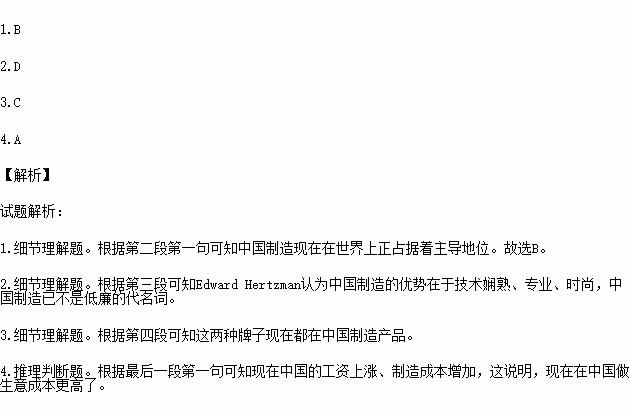题目内容
阅读理解。
“Made in China” has Changed
Many shoppers in the West still prize labels, boasting (吹嘘) a product was made in Italy without knowing that a growing number of Italian products come from factories that are Chinese?owned and staffed. The products which were marked “Made in China” gave the buyer an impression of “low pride and low cost, low technology and development”. The statement used to be true, but now it has changed.
“Made in China” is becoming a leading part in the world market. China's garment industry (制衣业) has been investing in producing technology and training for decades, and its workforce has collectively gotten better at sewing garments. As a result, the quality of Chinese?made clothes is rising fast. It has been home to a highly?skilled, highly?specialized garment industry, one that supplies even some high?end (高端的) labels and offers the best mix of price, speed, and quality.
“If I was to make a basic men's jean, I'd make that in Pakistan,” said Edward Hertzman, co?owner of the trade publication Sourcing Journal. “If I was going to make a fashionable women's garment, I would move to China because their skill set is better, their hand is better, their finishing is better, and they can handle that type of fashion.”
Indeed, luxury fashion labels now routinely make things in China. Burberry, Armani, and Prada have all produced things there, because they're still able to get good workmanship at a relatively low price. Even the Japanese brand Visvim, known for its crazy attention to detail, also produces high?end, handmade footwear in China.
Despite the rising wages and costs of doing business in China, companies have not walked away. “China is viewed by people who make buying decisions as unique and hard to copy elsewhere,” says Josh Green, CEO of Panjiva.
1.Which of the following is NOT true about “Made in China”?
A.It used to be associated with poor quality.
B.It has lost its leading status in the world market.
C.Its products are recognized by luxury fashion brands.
D.It reflects China's investment in producing technology.
2.Edward Hertzman thinks highly of “Made in China” in such aspects as ________.
①workers' skills ②low prices
③advanced technology ④a sense of fashion
A.①②③ B.①②④
C.②③④ D.①③④
3.What is the similarity between Prada and Visvim?
A.Both of them are from Japan.
B.Neither of them sells at a low price.
C.They both make products in China.
D.They both produce handmade footwear.
【小题】What can be learned from the last paragraph?
A.Doing business in China costs a lot more now.
B.Chinese companies are more creative than others.
C.Foreign producers want to copy China's success.
D.Rising costs stop the interest of foreign companies.

